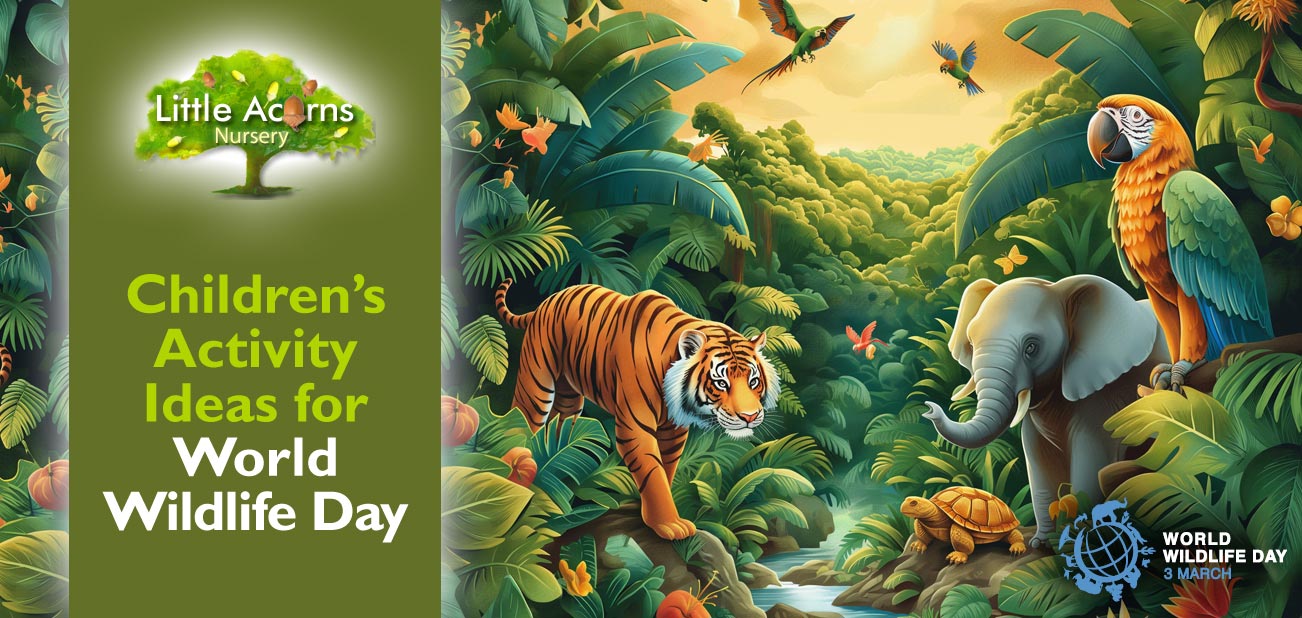
World Wildlife Day arrives in early March each year — just around the corner at the time of writing. The annual event is hugely important and very worthwhile. It is also a great opportunity to inspire children to get more interested in the natural world. By doing so, they will benefit wild animals and plants — as well as themselves through fun, learning and discovery. What’s more, many of the nature-inspired activities that we’ll suggest today are totally free.
Spending time in and around nature is incredibly good for children and World Wildlife Day offers families many opportunities to get much closer to it. As well as being great fun, such activities can open children’s eyes to humanity’s impact on the planet and help them understand the importance of looking after nature’s incredible flora and fauna. Learning about the plight of some of the Earth’s wild animals and plants will also nurture a greater respect for the natural world. It will help to encourage greener values, greater empathy, and a sense of responsibility in even the youngest children. It is also likely to instil in them a love for the great outdoors and encourage outdoor play, which is also hugely beneficial to children. With all that in mind, let’s dive into what World Wildlife Day stands for and then explore some of the children’s activities inspired by the initiative. Families right across the UK can take part, explore and discover. In so doing, they will self-improve, become more responsible citizens, and evolve into more effective stewards of this irreplaceable planet.
About World Wildlife Day
World Wildlife Day (‘WWD’) always arrives on the 3rd of March. In 2025, that will fall on a Monday, then in 2026 it’s a Tuesday — and so on. WWD is an initiative born in late 2013 at the United Nations General Assembly and is closely related to CITES, which is all about the conservation of endangered species of wild flora and fauna. So — it’s incredibly worthwhile and families can each play their part in raising awareness.
“UN World Wildlife Day has now become the global annual event dedicated to wild animals and plants.”
Activity Ideas for Children & Families
Children and families can get involved in World Wildlife Day in a variety of ways. For example, they can simply get out for walks in local parks and countryside to see some of nature’s flora and fauna, embark on activities to attract wildlife to their own gardens or, if the weather is inclement, get creative at home with some wildlife art. The only limit for possible wildlife-related activities is the imagination! That said, we’ve got some suggestions below to inspire families and children to get started.
Create Some Wildlife Art!
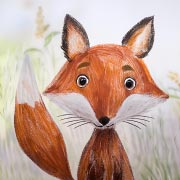 Children will love creating wildlife art. Whether it’s drawing animals and plants, making a collage, or constructing an animal out of cardboard or origami, wildlife art is a wonderful way to get children involved. What’s more, they will get a sense of satisfaction from the activity and it can help them appreciate wildlife more.
Children will love creating wildlife art. Whether it’s drawing animals and plants, making a collage, or constructing an animal out of cardboard or origami, wildlife art is a wonderful way to get children involved. What’s more, they will get a sense of satisfaction from the activity and it can help them appreciate wildlife more.
TIP: Use IFAW’s International Youth Art Contest art competition as possible inspiration. Although it’s now closed in 2025 for judging in readiness for the March event, you can view some previous entries to give your child inspiration (scroll to the bottom of that linked page to see the full gallery of examples).
Another great wildlife-related art activity is to challenge children to combine 2 or more creatures, thereby creating their own, new hybrid animal. Results can be inventive, endearing, or sometimes hilarious! [Examples].
Support a Wildlife-Related Charity
 Another incredibly worthwhile activity that children can get involved in is fundraising for a wildlife-related charity. This can be done, for example, through a sponsored activity of some kind. That could be a sponsored walk, hop, swim, or whatever children and families choose (under supervision, of course, for the youngest). A sponsored fundraising activity will not only raise funds for a wildlife charity of choice but also spread the word. Furthermore, children will get an enormous sense of achievement at the end when their actions raise vital funds for animals or conservation. Volunteering for local wildlife charities is also hugely worthwhile, of course, but it is more suited to when children are older.
Another incredibly worthwhile activity that children can get involved in is fundraising for a wildlife-related charity. This can be done, for example, through a sponsored activity of some kind. That could be a sponsored walk, hop, swim, or whatever children and families choose (under supervision, of course, for the youngest). A sponsored fundraising activity will not only raise funds for a wildlife charity of choice but also spread the word. Furthermore, children will get an enormous sense of achievement at the end when their actions raise vital funds for animals or conservation. Volunteering for local wildlife charities is also hugely worthwhile, of course, but it is more suited to when children are older.
“With over 1 million species estimated to be threatened with extinction, and facing the intensifying triple planetary crisis, innovative finance for wildlife conservation is more urgent than ever.”
Storytelling With a Wildlife Theme
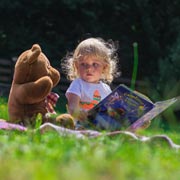 Challenging children to create stories involving wildlife and nature is both creative and fun! Adults/parents can lead by example, to begin with, so that the youngest children can get the idea. Whether the story involves feeding hungry squirrels in the forest, swimming with dolphins, going on an adventure in the jungle, or something entirely different, it’s sure to pique children’s interest. It will stimulate children’s imaginations and natural spirit of adventure as well as helping to raise awareness of some of the issues facing wildlife.
Challenging children to create stories involving wildlife and nature is both creative and fun! Adults/parents can lead by example, to begin with, so that the youngest children can get the idea. Whether the story involves feeding hungry squirrels in the forest, swimming with dolphins, going on an adventure in the jungle, or something entirely different, it’s sure to pique children’s interest. It will stimulate children’s imaginations and natural spirit of adventure as well as helping to raise awareness of some of the issues facing wildlife.
Challenge the Family to Live More Sustainably
 World Wildlife Day brings into focus the enormous challenges that affect nature’s flora and fauna. Sadly, many of those challenges are caused by humans, whether it’s due to habitat loss, global warming, or something else. By raising awareness through World Wildlife Day activities, children and families can also challenge themselves to live more sustainably. This is a whole topic in itself! However, some easy measures can be things like:
World Wildlife Day brings into focus the enormous challenges that affect nature’s flora and fauna. Sadly, many of those challenges are caused by humans, whether it’s due to habitat loss, global warming, or something else. By raising awareness through World Wildlife Day activities, children and families can also challenge themselves to live more sustainably. This is a whole topic in itself! However, some easy measures can be things like:
- cutting out food containing palm oil, which is responsible for the clearance of huge swathes of forests and jungles;
- stopping the use of harmful chemicals in the home and garden (slug killers, pesticides and weedkillers, for example);
- eating more vegetarian and vegan food options, which is better for the environment and, of course, animals;
- recycling more waste;
- using more sustainable, wildlife-friendly products in the home;
- and reducing the use of plastics.
It’s a huge topic, so some research will be needed although our examples are a great starting point and are good things to bring to children’s attention.
Visit a Local Zoo or Wildlife Sanctuary
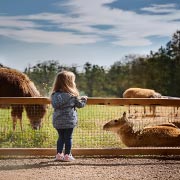 Children can also get closer to wild flora and fauna if they live near a wildlife sanctuary (or zoo) or somewhere like a national park. Nothing can really replace seeing animals and plants in real life and so it’s worth researching to find somewhere to visit close by. In Lancashire, just five miles from Little Acorns Nursery, for example, is Turbary Woods Owl & Bird of Prey Sanctuary, which is well worth a visit. There, kids can see owls, falcons, hawks and more. Visiting will support this non-profit enterprise, educate little ones and give them a wonderful day out.
Children can also get closer to wild flora and fauna if they live near a wildlife sanctuary (or zoo) or somewhere like a national park. Nothing can really replace seeing animals and plants in real life and so it’s worth researching to find somewhere to visit close by. In Lancashire, just five miles from Little Acorns Nursery, for example, is Turbary Woods Owl & Bird of Prey Sanctuary, which is well worth a visit. There, kids can see owls, falcons, hawks and more. Visiting will support this non-profit enterprise, educate little ones and give them a wonderful day out.
Plant & Food Growing
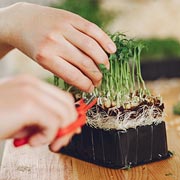 Teaching children how to grow their own plants and, better still, food is a wonderfully educational and fulfilling activity. As well as learning to appreciate wild plants growing in parks and the countryside, learning how to grow their own, at home, is also great fun. Luckily, we have a whole blog post dedicated to Food Growing for Kids, so do take a look.
Teaching children how to grow their own plants and, better still, food is a wonderfully educational and fulfilling activity. As well as learning to appreciate wild plants growing in parks and the countryside, learning how to grow their own, at home, is also great fun. Luckily, we have a whole blog post dedicated to Food Growing for Kids, so do take a look.
Take Children on a Nature Scavenger Hunt!
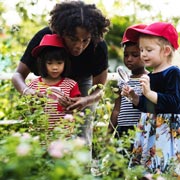 A nature scavenger hunt is also great fun and is sure to get children interested in nature, wildlife, and the outdoors. The activity involves looking out for specific natural things, for example, a pine cone, a robin, a squirrel’s drey (i.e. nest), a winged seed, or animal tracks. It will also give children exercise and get them closer to nature in a fun, engaging activity. To make it easier, check out our free Nature Hunt activity reference sheets; our Winter Nature Hunt activity is here and, for later in the year, our Autumn Nature Hunt can be found here. We’ll be adding more to that series in due course.
A nature scavenger hunt is also great fun and is sure to get children interested in nature, wildlife, and the outdoors. The activity involves looking out for specific natural things, for example, a pine cone, a robin, a squirrel’s drey (i.e. nest), a winged seed, or animal tracks. It will also give children exercise and get them closer to nature in a fun, engaging activity. To make it easier, check out our free Nature Hunt activity reference sheets; our Winter Nature Hunt activity is here and, for later in the year, our Autumn Nature Hunt can be found here. We’ll be adding more to that series in due course.
Animal & Bird Spotting
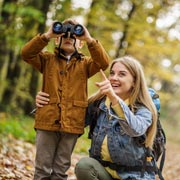 Encouraging (and supervising, where appropriate) an activity where children try to see different types of animals, birds, and insects is also a wonderful way to get them interested in nature. To make it easier, we have published some free, downloadable reference sheets, which also double as posters, for families to use during this activity. These include one for British birds, another for British land mammals, one for British butterflies, and one for minibeasts that children are likely to find in gardens and compost heaps.
Encouraging (and supervising, where appropriate) an activity where children try to see different types of animals, birds, and insects is also a wonderful way to get them interested in nature. To make it easier, we have published some free, downloadable reference sheets, which also double as posters, for families to use during this activity. These include one for British birds, another for British land mammals, one for British butterflies, and one for minibeasts that children are likely to find in gardens and compost heaps.
Attracting Wildlife to Your Garden
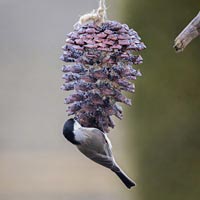 If children like the idea of attracting birds and other wildlife to their own garden, there are many easy ways to make this possible. As well as putting out suitable food to attract birds, children can help make a quiet, wild area with a compost heap to attract minibeasts. There are so many ways to attract wildlife so, to get you started, check out our wildlife-friendly flower-growing activity here, our make-your-own bird feeders activity and then be sure to read our guide to bird feeding for under-fives. And don’t forget — ditch the harmful chemicals like weedkillers, pesticides, slug and snail killers. After all, if a bird or animal eats something affected, it will also then be in danger from such poisons — and beautiful pollinators like bees and butterflies are being decimated by pesticides. Our children are tomorrow’s stewards of the planet, so it’s important to educate them to form good habits and show empathy towards wildlife.
If children like the idea of attracting birds and other wildlife to their own garden, there are many easy ways to make this possible. As well as putting out suitable food to attract birds, children can help make a quiet, wild area with a compost heap to attract minibeasts. There are so many ways to attract wildlife so, to get you started, check out our wildlife-friendly flower-growing activity here, our make-your-own bird feeders activity and then be sure to read our guide to bird feeding for under-fives. And don’t forget — ditch the harmful chemicals like weedkillers, pesticides, slug and snail killers. After all, if a bird or animal eats something affected, it will also then be in danger from such poisons — and beautiful pollinators like bees and butterflies are being decimated by pesticides. Our children are tomorrow’s stewards of the planet, so it’s important to educate them to form good habits and show empathy towards wildlife.
These are Learning Opportunities
As a parent, you’ll notice that these activities are learning opportunities for children and also include many teachable moments. Through such activities, children will begin to understand the impact that they have on other living things around them and the environment as a whole. They can then adopt greener values, improve feelings of empathy, and understand how to be more responsible citizens. In short, they can self-improve while making the world a better place. Such is the power of the opportunity that World Wildlife Day offers to families who celebrate it. Enjoy!
A Childcare Place at Little Acorns Nursery, Clayton-le-Woods
Weekday Childcare for Babies, Toddlers & Preschoolers Near Chorley

 The staff at Little Acorns Nursery in Clayton-le-Woods hope that families enjoy today’s post and the activities suggested therein. We know how important nature is to children and, indeed, have our own gardens where children can connect with nature and enjoy the freedom of outdoor activities.
The staff at Little Acorns Nursery in Clayton-le-Woods hope that families enjoy today’s post and the activities suggested therein. We know how important nature is to children and, indeed, have our own gardens where children can connect with nature and enjoy the freedom of outdoor activities.
If you’d like to consider a possible nursery place for your baby or child at Little Acorns, please get in touch using one of the options below. We support many of the government’s childcare funding schemes including free childcare for eligible babies from 9 months of age. As well as being a nursery and preschool for families in Clayton-le-Woods and Chorley, we may also suit those nearby in Clayton Brook, Clayton Green, Thorpe Green, Pippin Street, Buckshaw Village, Whittle-le-Woods, Farington, Bamber Bridge, Lostock Hall, Euxton, Leyland and Penwortham.



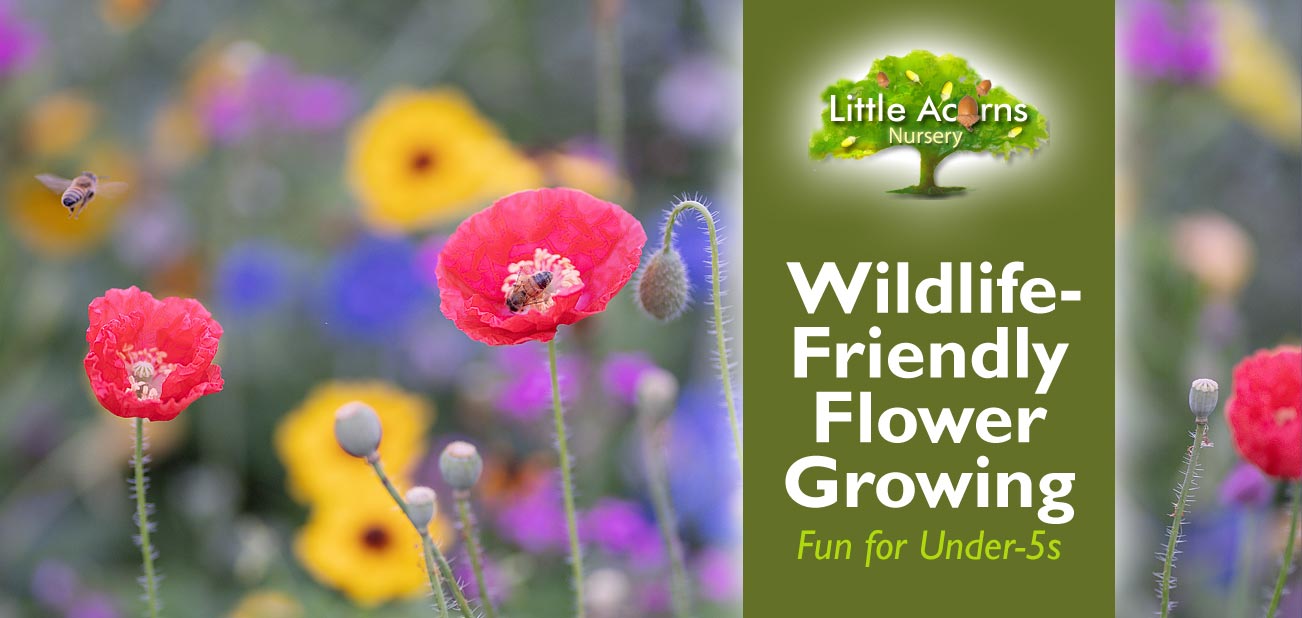
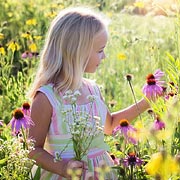 Today’s flower-growing children’s activity follows on nicely from last month’s
Today’s flower-growing children’s activity follows on nicely from last month’s 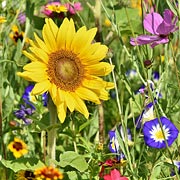 It’s possible to sow wildflower seeds from March right through to mid-October or, at a push, early November so long as snow or frost is not forecast. Those sown closer to March and April will generally flower in late spring/early summer. Those sown very late in the year will flower the following year, from spring onwards. Any sown up to and including the middle period, for example during July, should still flower in the same year — wildflowers usually bloom some 60 to 80 or so days later if they’re timed to grow in the same year as they’re sown.
It’s possible to sow wildflower seeds from March right through to mid-October or, at a push, early November so long as snow or frost is not forecast. Those sown closer to March and April will generally flower in late spring/early summer. Those sown very late in the year will flower the following year, from spring onwards. Any sown up to and including the middle period, for example during July, should still flower in the same year — wildflowers usually bloom some 60 to 80 or so days later if they’re timed to grow in the same year as they’re sown.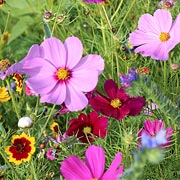 There are several ways for children and families to source wildflower seeds. The most obvious way is to buy them commercially, in seed packets. These are available from any number of different outlets including nurseries, supermarkets,
There are several ways for children and families to source wildflower seeds. The most obvious way is to buy them commercially, in seed packets. These are available from any number of different outlets including nurseries, supermarkets, 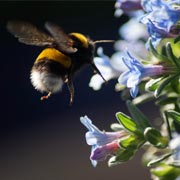 If you buy your child commercially-available wildflower seeds, the information on the packet will often say if the resulting flowers are bee-friendly, butterfly-friendly, good for pollinators, and so on. So, if you’re sourcing seeds that way, much of the decision-making criteria around which actual flowers to grow is made clear and therefore the choice is easy.
If you buy your child commercially-available wildflower seeds, the information on the packet will often say if the resulting flowers are bee-friendly, butterfly-friendly, good for pollinators, and so on. So, if you’re sourcing seeds that way, much of the decision-making criteria around which actual flowers to grow is made clear and therefore the choice is easy.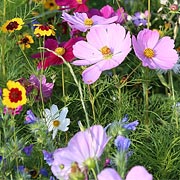 By their very nature, wildflowers are generally not very picky in regard to the type of soil they are happy to grow in. Therefore you/your child will have a greater choice of where to sow the wildflower seeds. A fairly clear sunny area is good, whether that’s garden beds, flower pots, window boxes, grow bags on a balcony, or even the lawn itself if you want a wild ‘meadow’ type lawn. Whatever the choice, it’s best if it’s somewhere that won’t be disturbed by you/the family though, as you wouldn’t want the wildflowers trampled once they do arrive.
By their very nature, wildflowers are generally not very picky in regard to the type of soil they are happy to grow in. Therefore you/your child will have a greater choice of where to sow the wildflower seeds. A fairly clear sunny area is good, whether that’s garden beds, flower pots, window boxes, grow bags on a balcony, or even the lawn itself if you want a wild ‘meadow’ type lawn. Whatever the choice, it’s best if it’s somewhere that won’t be disturbed by you/the family though, as you wouldn’t want the wildflowers trampled once they do arrive. With regard to sowing the seeds, follow any seed-specific instructions on packets in relation to timing and spacing. If you’re using self-harvested seeds or there are no instructions, simply sprinkle the seeds so they’re spaced, fairly evenly, i.e. not too densely sown. This will avoid the wildflower plants having to compete with one another once they start growing. A tip is to sprinkle from a height as this will naturally scatter them more widely. Once scattered, your child can help* to pat the soil surface down, either by hand or using the back of a tool like a spade or a trowel, so that the seeds are secured in the soil. Children can even ‘walk’ them in if they prefer. Once complete, ensure that you/your child keep the soil damp over the coming weeks. The preparation stage really is as simple as that!
With regard to sowing the seeds, follow any seed-specific instructions on packets in relation to timing and spacing. If you’re using self-harvested seeds or there are no instructions, simply sprinkle the seeds so they’re spaced, fairly evenly, i.e. not too densely sown. This will avoid the wildflower plants having to compete with one another once they start growing. A tip is to sprinkle from a height as this will naturally scatter them more widely. Once scattered, your child can help* to pat the soil surface down, either by hand or using the back of a tool like a spade or a trowel, so that the seeds are secured in the soil. Children can even ‘walk’ them in if they prefer. Once complete, ensure that you/your child keep the soil damp over the coming weeks. The preparation stage really is as simple as that!
